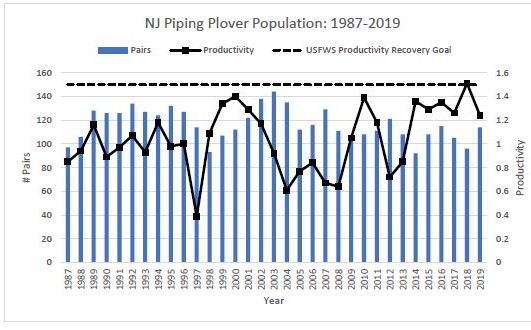Cautious Optimism for New Jersey’s Endangered Piping Plovers in 2019 Report
by: Alison Levine, Communications Coordinator

Photo courtesy of Bill Dalton.
A new report from Conserve Wildlife Foundation and the New Jersey Division of Fish and Wildlife shows that the state’s piping plover population increased in 2019, leading to cautious optimism for the birds’ long term prospects. The piping plover is listed as threatened federally and endangered in New Jersey.
One hundred fourteen pairs of piping plovers nested in New Jersey in 2019, a 19% increase over 2018’s 96 pairs. The 2019 population is slightly below the long-term average of 117 pairs and well below the peak of 144 pairs in 2003.
Piping plover productivity, measured by the number of chicks who survive until their first flight (or fledging), dropped from 1.51 in 2018 to 1.24 in 2019, and was the lowest seen in the last six years, but remains above the long-term average of 1.3.
The number of sites in New Jersey where piping plovers nested was up significantly to 27, from just 19 sites in 2018, reversing a decade-long trend of hovering in the mid-to-low 20’s. Sites in the federally protected Gateway National Recreation Area’s Sandy Hook Unit and the E.B. Forsythe National Wildlife Refuge’s Holgate and Little Beach Units house 71% of the statewide population.
These federal lands remain a crucial factor in the piping plovers’ recovery. They provide the state’s best nesting and foraging habitats, and recreational use can be better managed than elsewhere in New Jersey. However, federal sites at full capacity are not enough to create a stable population and recovery will only happen if pairs are more equally distributed throughout the state. Suitable habitat does exist outside of federal lands and CWF and the Division of Fish and Wildlife continue to work with managers of local and state beaches to promote suitable habitat and management.

The report authors also prepared a short 2019 summary for three other species of beach-nesting birds in the state: the black skimmer, which is state endangered; the least tern, also state endangered; and the American oystercatcher, a species of special concern.
Black skimmer statewide productivity showed a marked decline from 2018 with 403 chicks fledging statewide, versus 941 in 2018. Productivity was moderate for least terns with 376 fledglings statewide (0.60 chicks per pair, based on the peak number of incubating adults). Seventy one American oystercatcher chicks fledged in New Jersey in 2019, up from 45 in 2018, but the 0.48 fledglings per pair is slightly lower than the .5 recommended by the American Oystercatcher Working Group.
Recovery of beach nesting birds benefits not only the birds themselves, but New Jersey as a whole. By protecting their habitat, we are also protecting the many human homes, businesses and recreational activities that rely on those beaches and dunes for protection from storms. Protecting our dunes and shores continues to grow in importance as climate change brings more frequent and severe storms to our state.
The birds themselves also act as an economic driver. Tourists come for bird watching and stay at local hotels, eat in local restaurants, and shop in local stores. The U.S. Fish and Wildlife Service estimated in 2016 that wildlife watching, including bird watching, added $800 billion to the U.S. economy. Another national study looked specifically at birdwatching and found it has an annual economic benefit of $41 billion nationally.
New Jersey has two of the 10 most popular US destinations for bird watching – Cape May National Wildlife Refuge, at number five, and the Edwin B. Forsythe National Wildlife Refuge, at number nine. Cape May County’s research on tourism in 2018 showed that eco-tourism is a $600 million industry in the county, and more than half (68%) comes from birding and watchable wildlife activities.
In order to protect New Jersey’s people, birds and businesses it is crucial to gather the type of on the ground information summarized in the recent report. Knowing how many birds are in the state, where they are and how to protect them is the foundation of conservation plans. CWF thanks our partners at New Jersey Division of Fish and Wildlife and all our supporters and volunteers for making this important work possible.
Resources:
- CWF Beach Nesting Bird Project
- Piping Plover Nesting Results in New Jersey: 2019
- 2019 New Jersey Beach Nesting Bird Project Report
- WHYY: N.J.’s endangered piping plover population increased in 2019, but researchers are cautiously optimistic
- NJ101.5: More Plovers Nested in NJ This Year
Discover more from Conserve Wildlife Foundation of NJ
Subscribe to get the latest posts sent to your email.